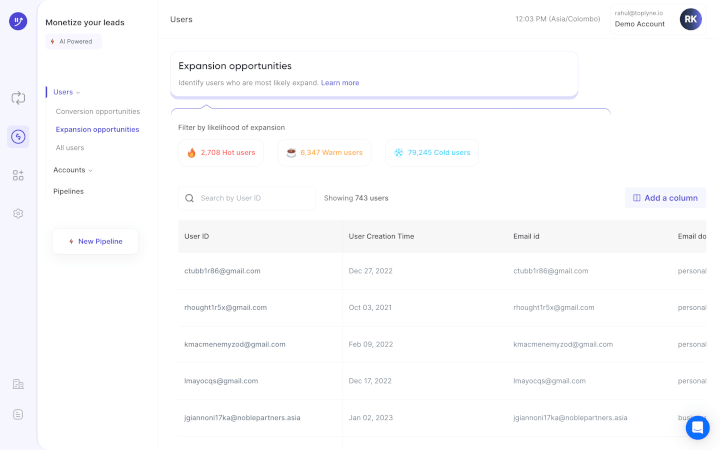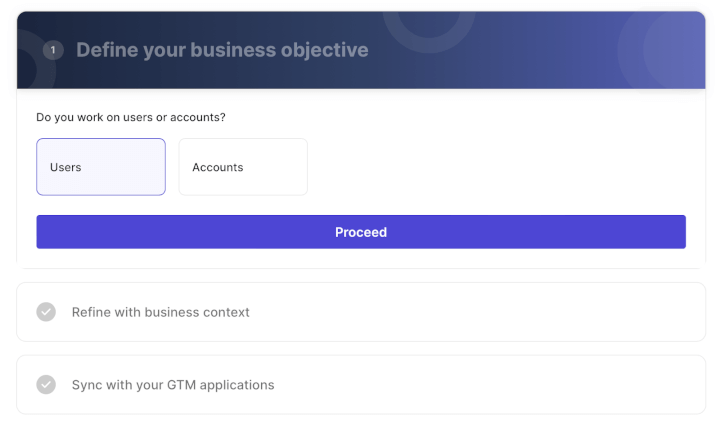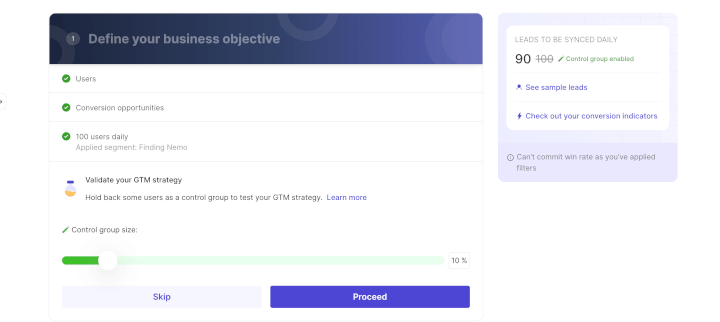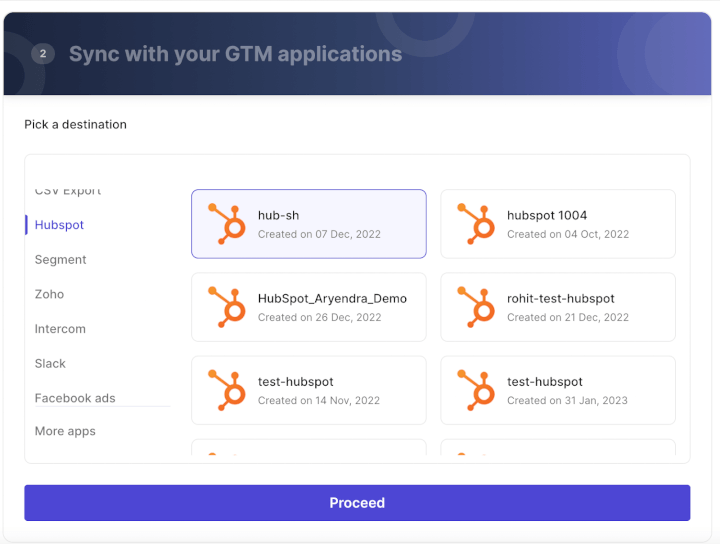4 Third-Party Data Points for Better Lead Scoring

The ultimate goal of sales optimization is to win deals. Closing deals is easier when you’re the right prospects. Lead scoring is a method to find users who are most likely to buy your product or sign up for your free trial. Your sales reps can make better use of their time by focusing on converting these high-intent leads. Converging your sales processes around these leads get you closer to your quota and provide insights into processes that need improvements.
The more you know about your leads, the better you can predict their likelihood of buying from you. This is possible when you have accurate and relevant information about them and an understanding of their behavioral patterns. Or what is known as third-party data enrichment. Third-party because the data is collected by an entity other than your organization, such as an online business publication or a dedicated data aggregator for B2B companies. External sources will be necessary to supplement internally held knowledge or research, helping ensure a 360-degree view of leads.
I. Understanding Lead Scoring
A. Definition of lead scoring and its significance for sales teams
Lead scoring is a methodology that ranks prospects on a numerical scale representing each lead's perceived value to your company. Lead scoring is a method of evaluating the quality of sales leads by objectively ranking one lead against another based on buyer profile fit and behavior criteria.
In a typical lead scoring process, when a lead approaches a predetermined score, they are deemed qualified leads ready to move further down the sales funnel and ready to be received by the sales team. Not all of these quality leads will end up signing a contract with you. But the best leads identified through the process will more than likely convert.
B. Benefits of a data-driven approach to lead prioritization
Intuition serves an important function in sales. But relying solely on gut feeling is unwise, especially in an age where target audience data is readily available. Sales and marketing teams guided by data in their CRMs and from third-party sources can identify good leads effectively and build better lead scoring systems. Their instincts and professional experiences play a part but are incomparable to data's enormous value.
II. The Power of Third-Party Data
A. Explanation of third-party data and its relevance in lead scoring
Third-party data can be enrichment data or intent data. Enrichment data is all the relevant information on users based on what they do, their decision-makers, the technologies they use, and so on. Intent data covers the purchasing intent of users based on their online behaviors.
The data is available on business websites, social media like LinkedIn and Facebook, market research websites, or from third-party providers that enrich your understanding of user behaviors. This data and the data you hold in your organizational systems, such as your HubSpot CRM, provide a well-rounded understanding of your user and help with lead prioritization.
B. Advantages of supplementing first-party data with external insights
Third-party data expands insights found in the data collected by your teams. You can use it for predictive lead scoring, which automatically matches the attributes and behaviors of existing users with prospects, by leveraging first-party product, sales and marketing data and third-party data such as enrichment and intent data. A predictive lead scoring model uses machine learning to build the ideal customer profile and can enhance the efficacy of your lead scoring model.
III. Top Five Third-Party Data Points for Lead Scoring
A. Data Point 1: Technographic Data
1. Definition and examples of technographic data
A company’s technographic data is the information related to the software and hardware technology stacks it uses. For example, its marketing automation systems, accounting software, customer feedback management systems, applicant tracking systems, etc.
2. How technographics influence lead qualification and targeting
With technographic data, you can target companies based on their tech stack. Some companies may already have a comparable solution; others may need to. This information will help you identify the leads to prioritize and craft sales conversations based on what your prospects want to hear.
3. Three tools to collect technographic data
- Clearbit
- ZoomInfo
- Apollo
B. Data Point 2: Firmographic Data
1. Definition and significance of firmographics for lead scoring
Firmographic data consists of the prospect’s industry, years in business, company size, organizational structure, geographical location, number of employees, and annual revenue. You can use this information to create different market segments and identify high-value prospects.
2. Leveraging firmographic insights to understand ideal customers
Some industries are more likely than others to derive greater value from utilizing your product. Companies with mature processes may be ready for your product and a better fit than those with nascent processes.
3. Three tools to collect firmographic data
- Zoominfo
- Clearbit
- Lusha
C. Data Point 3: Intent Data
1. Explanation of intent data and its role in gauging prospect interest
Intent data shows which leads are actively researching solutions on third-party sites. Their visits to product review sites, blogs, pricing pages, and platforms like G2 can gauge their interest. They may download case studies, whitepapers, or other knowledge resources from third-party sites. This behavioral data helps you gauge leads’ readiness to try a solution you provide.
2. Incorporating intent signals for real-time lead prioritization
You can monitor leads’ online activities and use the intent signals for your lead scoring system. Strong intent signals don’t necessarily require immediate sales outreach. Consider other lead data to prioritize and who to target and focus more intently in the sales pipeline.
3. Tools to collect intent data
Landing, product, or pricing page visits; blog subscriptions; social media engagement; and resource downloads are examples of first-party intent data. You can also buy this data from third-party providers that aggregate information from product review sites, channel partners, and ad exchanges.
D. Data Point 4: Demographic Data
1. Importance of demographic data in lead profiling
B2B demographic data covers the decision-makers at prospective companies. It includes their personal and geographical information such as their name, email address, telephone number, job title, age, skills, and employment history. The information is essential to create lead profiles and targeted sales communications.
2. Personalization opportunities based on demographic insights
Job titles will tell you how much decision-making power the lead has. Based on past customer data, you may infer that certain roles respond better to certain messaging or prefer certain knowledge resources over others compared to other roles. For example, a busy senior technology executive may prefer reading your whitepaper rather than attending your webinar. These inferences and insights will help you personalize and target your sales outreach strategy more effectively.
3. 3 tools to collect demographic data
- Social media, particularly LinkedIn
- Company website
- Your website form
IV. Integrating Third-Party Data into Your Lead Scoring Model
Combining external data and signals poses challenges for businesses. For one, the data is often noisy, making it difficult for other teams working with it. Aggregating the data, removing data noise, and summarizing the data require engineering bandwidth, which is also hard given the multiple competing priorities engineers typically deal with. Purchasing third-party data can be a costly affair in the long term. As such, a single solution that can collect and integrate data is more efficient and cost-effective in the long run.
V. Best Practices for Data-Driven Lead Scoring
A. Defining lead scoring criteria and weighting factors
As you’ll be collecting different types of data on leads, your lead scoring system must have rules defining the combination of criteria to qualify those leads. For example, is a qualified lead one who has an annual revenue of over $10M, visits your pricing page, checks out product reviews, and downloads your whitepaper? Should the lead fulfill all four criteria to be moved down the sales funnel?
Most lead scoring systems are based on a scale of 1-100. Assign points to every action based on its importance. For example, you can assign a higher weightage of, say, +10 points for a visit to the pricing page and +5 for downloading a case study. Lead scoring tools also have negative scoring for companies that aren’t a great prospect yet. Appropriately, you can assign -5 points for visits to your career page.
Heuristic-based lead scoring involves setting certain rules, which when reached, trigger specific GTM touchpoints to your users and accounts to nudge them to conversion, expansion, or custom outcomes you want your users to achieve within your product like the above.
B. AI-based lead scoring
Predictive lead scoring is an algorithm-based machine learning segmentation strategy that uses all historical customer data to continuously calculate a score for each lead in real-time.
Tools like Toplyne, continuously segment and score your leads to surface conversion and expansion pipeline in your CRM for your sales teams to go after. This helps your reps prioritize the right leads and save dozens of hours every sales cycle. The key difference between predictive lead scoring and other manual methods is that it can be automated. Its fast-paced, self-learning algorithm is the basis for predictive segmentation’s speed and accuracy making it ideal for B2B companies. Read more about predictive lead scoring here.
Here’s how companies like Canva and Vercel generate sales pipeline from their self-serve funnel using Toplyne:
- Step 1/7: Create monetization playbooks to surface conversion and expansion opportunities (leads most likely to convert to paying customers, and teams most likely to grow into larger teams)

- Step 2/7: Choose the right leads to target – users (individual users) or accounts (a group of users with an organization).

- Step 3/7: Select the frequency at which you would want leads synced in your GTM apps.

- Step 4/7: Define how many leads you want by either the number of leads or your expected win rate, depending on your sales capacity and GTM strategy.

- Step 5/7: Build custom segments - Build custom segments based on And/Or logic at the deepest level of sub-properties within your product analytics.

- Step 6/7: Validate your GTM strategy - Hold back some users as a control group to test your GTM strategy.

- Step 7/7: Sync your product qualified pipeline into your GTM destinations - CRMs, sales & marketing execution tools, and customer engagement platforms.

VI. Conclusion
Third-party data is crucial for SaaS companies looking to establish a solid lead generation system and support their sales teams in achieving a healthy win rate. Unified access to customer data using a tool like Toplyne enables you to prioritize leads in a data-driven way and boost your sales outcomes.


.svg)









.png)